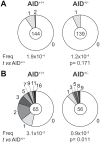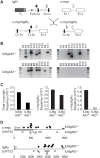Haploinsufficiency of activation-induced deaminase for antibody diversification and chromosome translocations both in vitro and in vivo
- PMID: 19079594
- PMCID: PMC2592691
- DOI: 10.1371/journal.pone.0003927
Haploinsufficiency of activation-induced deaminase for antibody diversification and chromosome translocations both in vitro and in vivo
Abstract
The humoral immune response critically relies on the secondary diversification of antibodies. This diversification takes places through somatic remodelling of the antibody genes by two molecular mechanisms, Class Switch Recombination (CSR) and Somatic Hypermutation (SHM). The enzyme Activation Induced Cytidine Deaminase (AID) initiates both SHM and CSR by deaminating cytosine residues on the DNA of immunoglobulin genes. While crucial for immunity, AID-catalysed deamination is also the triggering event for the generation of lymphomagenic chromosome translocations. To address whether restricting the levels of AID expression in vivo contributes to the regulation of its function, we analysed mice harbouring a single copy of the AID gene (AID(+/-)). AID(+/-) mice express roughly 50% of normal AID levels, and display a mild hyperplasia, reminiscent of AID deficient mice and humans. Moreover, we found that AID(+/-) cells have an impaired competence for CSR and SHM, which indicates that AID gene dose is limiting for its physiologic function. We next evaluated the impact of AID reduction in AID(+/-) mice on the generation of chromosome translocations. Our results show that the frequency of AID-promoted c-myc/IgH translocations is reduced in AID(+/-) mice, both in vivo and in vitro. Therefore, AID is haploinsufficient for antibody diversification and chromosome translocations. These findings suggest that limiting the physiologic levels of AID expression can be a regulatory mechanism that ensures an optimal balance between immune proficiency and genome integrity.
Conflict of interest statement
Figures




Similar articles
-
Activation-induced cytidine deaminase in antibody diversification and chromosome translocation.Adv Cancer Res. 2012;113:167-90. doi: 10.1016/B978-0-12-394280-7.00005-1. Adv Cancer Res. 2012. PMID: 22429855 Free PMC article. Review.
-
AID dysregulation in lupus-prone MRL/Fas(lpr/lpr) mice increases class switch DNA recombination and promotes interchromosomal c-Myc/IgH loci translocations: modulation by HoxC4.Autoimmunity. 2011 Dec;44(8):585-98. doi: 10.3109/08916934.2011.577128. Epub 2011 May 18. Autoimmunity. 2011. PMID: 21585311 Free PMC article.
-
AID targeting in antibody diversity.Adv Immunol. 2011;110:1-26. doi: 10.1016/B978-0-12-387663-8.00005-3. Adv Immunol. 2011. PMID: 21762814 Review.
-
Activation-induced deaminase: light and dark sides.Trends Mol Med. 2006 Sep;12(9):432-9. doi: 10.1016/j.molmed.2006.07.001. Epub 2006 Jul 24. Trends Mol Med. 2006. PMID: 16861038 Review.
-
A role for AID in chromosome translocations between c-myc and the IgH variable region.J Exp Med. 2007 Sep 3;204(9):2225-32. doi: 10.1084/jem.20070884. Epub 2007 Aug 27. J Exp Med. 2007. PMID: 17724134 Free PMC article.
Cited by
-
PDGFA-associated protein 1 protects mature B lymphocytes from stress-induced cell death and promotes antibody gene diversification.J Exp Med. 2020 Oct 5;217(10):e20200137. doi: 10.1084/jem.20200137. J Exp Med. 2020. PMID: 32609329 Free PMC article.
-
Activation-induced cytidine deaminase in antibody diversification and chromosome translocation.Adv Cancer Res. 2012;113:167-90. doi: 10.1016/B978-0-12-394280-7.00005-1. Adv Cancer Res. 2012. PMID: 22429855 Free PMC article. Review.
-
B cell TLRs and induction of immunoglobulin class-switch DNA recombination.Front Biosci (Landmark Ed). 2012 Jun 1;17(7):2594-615. doi: 10.2741/4073. Front Biosci (Landmark Ed). 2012. PMID: 22652800 Free PMC article. Review.
-
YY1 controls immunoglobulin class switch recombination and nuclear activation-induced deaminase levels.Mol Cell Biol. 2012 Apr;32(8):1542-54. doi: 10.1128/MCB.05989-11. Epub 2012 Jan 30. Mol Cell Biol. 2012. PMID: 22290437 Free PMC article.
-
Transcription factor YY1 can control AID-mediated mutagenesis in mice.Eur J Immunol. 2018 Feb;48(2):273-282. doi: 10.1002/eji.201747065. Epub 2017 Nov 14. Eur J Immunol. 2018. PMID: 29080214 Free PMC article.
References
-
- Schatz DG. V(D)J recombination. Immunol Rev. 2004;200:5–11. - PubMed
-
- Peled JU, Kuang FL, Iglesias-Ussel MD, Roa S, Kalis SL, et al. The biochemistry of somatic hypermutation. Annu Rev Immunol. 2008;26:481–511. - PubMed
-
- Di Noia JM, Neuberger MS. Molecular mechanisms of antibody somatic hypermutation. Annu Rev Biochem. 2007;76:1–22. - PubMed
-
- Stavnezer J. Antibody class switching. Adv Immunol. 1996;61:79–146. - PubMed
-
- Stavnezer J. Molecular processes that regulate class switching. Curr Top Microbiol Immunol. 2000;245:127–168. - PubMed
Publication types
MeSH terms
Substances
Grants and funding
LinkOut - more resources
Full Text Sources
Molecular Biology Databases

